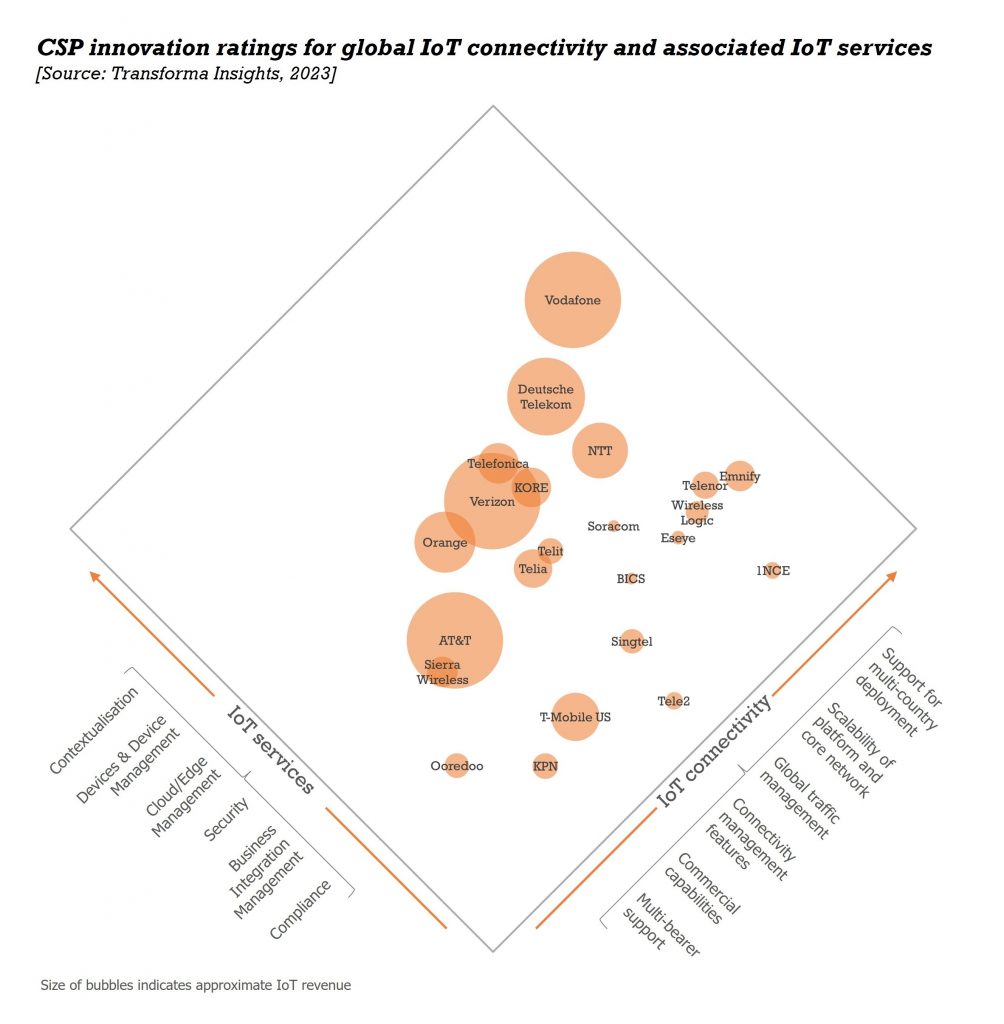London, UK. 23 February 2023 – Technology industry analyst firm Transforma Insights has today published its annual Communications Service Provider IoT Peer Benchmarking report. The report is based on detailed analysis of the strategies and capabilities of 23 leading global providers of cellular-based IoT connectivity. It assesses the key trends in the sector and identifies best practice and innovation from those vendors.
A rapidly evolving market: 24 key trends
It is a time of great disruption in the provision of IoT connectivity, particularly where it comprises connecting devices in multiple countries. Based on the extensive discussions with Communications Service Providers, Transforma Insights has identified as set of 24 key trends, as illustrated below.

Some of the key market dynamics today include:
- Easier market entry. The shift of connectivity into the software domain continues, allowing for more market entrants and greater innovation in the provision of IoT connectivity services.
- Provision of multi-country connectivity is in a period of transition. We’re in an interregnum between the old world of sponsored roaming and physically switching SIMs, and a new one based on eSIM and other more refined options for localisation. The current situation is something of a scrum but it will improve.
- NB-IoT and LTE-M will emerge as market leading technologies. For some players and in some geographies this is already the case. But there are still issues with coverage, optimisation and roaming.
- Scalability is increasingly the watchword for IoT connectivity. This is not particularly new and was the focus of the previous iteration of this report. Harnessing the cloud and virtualising platforms and network elements is clearly critical to that process.
- Contextualisation is the order of the day. IoT connectivity providers need to understand the needs of the customer and adapt accordingly, providing a service wrap to the connectivity offering, with some elements of customisation and tailoring. Additional they need to adapt to treating customers as long-term partners rather than short-term transactions.
- Forget going ‘up the stack’ and focus on adjacent services. CSPs should seek further revenue opportunities through value added services such as security, compliance and analytics. They must be very wary of moving ‘up the stack’ and providing end-to-end solutions; there are opportunities but being a ‘me too’ provider is destined to fail.
- Don’t forget the devices. Being involved in devices is also increasingly a necessity for connectivity providers. There is an increasing overlap between the two markets through factors like eSIM and the need to cross-optimise solution elements when using constrained technologies. This includes also device lifecycle.
Report author, Matt Hatton says, “As part of our research we keep a constant watch on what is happening in the IoT connectivity space, but it’s good once a year to do a deep dive into the strategies and capabilities of all of the players. And that deep dive confirmed our view: we are in a period of transition triggered by technological change and by evolving commercial models. In the next few years we expect more innovation, new leaders to emerge, more consolidation and the emergence of a new scalable norm for supporting connectivity based on control, transparency, localisation, compliance and being cloud-native.”
MNO existential angst and ‘harnessing MVNO energy’
Collectively over the last 2-3 years the mobile network operator (MNO) portion of the IoT connectivity landscape has been seized with existential angst over its approach to the IoT connectivity space. Many of the MNOs have radically overhauled their structure and approach to the market recently and this is ongoing, with AT&T recently restructure, Aeris completely changing tack by taking over Ericsson’s IoT business, and Vodafone looking at options for some form of spin out.
Commenting on this trend, Hatton adds, “This should not be seen in a negative light. It’s part of a wider introspection within the IoT space, with organisations as diverse as Bosch, Google, IBM and SAP rethinking their approaches to the market to reflect the world as it is, rather than how they anticipated it would be.”
This contrasts with the increasing confidence of IoT MVNOs. Last year’s report profiled just two MVNOs: Aeris Communications and KORE. This year’s includes nine: 1NCE, BICS, Emnify, Eseye, KORE, Sierra Wireless, Soracom, Telit and Wireless Logic. It is impossible to ignore the growing importance of these organisations, not least because they are often the most innovative players. The focus of this report is on innovation and best practice, both of which are better addressed by expanding to cover MVNOs.
Hatton comments, “The MVNOs are where much of the innovation is happening, and it’s notable that many MNOs are seeking to harness ‘MVNO energy’ for their own operations.”
Which vendors top our ratings?
As we pull together these studies of the capabilities of IoT Connectivity Providers there is always the question: who’s the best?
Hatton comments, “This is, at its heart, the most reductive of questions. The answer will always be “it depends”. It depends on innumerable factors, including the capabilities that you need, the location of your devices, your preferred commercial models or even which cloud provider you use. We have elected to focus on innovation and best practice: which of these IoT Connectivity Providers has the most scalable, compliant, transparent and/or future-proof approaches to addressing the various elements of IoT connectivity and adjacent IoT services. That way we can, in some way, provide a useful comparison of capabilities.”
The Transforma Insights assessment has two dimensions. The first relates to pure IoT connectivity, including factors such as how multi-country connectivity is addressed, scalability, mechanisms for global traffic management and features. The second looks at those factors that are immediately adjacent as other Service Domains in IoT, including devices, cloud/edge, security, compliance and contextualisation. These are presented in the chart below, along with estimated IoT revenue as a proxy for the scale of the CSP’s IoT operations.
The highest overall highest rated vendor in our analysis, across both IoT connectivity and IoT services is Vodafone. Other major MNOs also score well, including Deutsche Telekom, NTT, Telefonica, Verizon and Orange. Their success tends to be skewed towards the IoT Services, whereas the increasingly assertive IoT MVNOs are more strongly positioned for pure IoT connectivity. We highlight 1NCE, Emnify, Eseye and Wireless Logic as having pulled together compelling connectivity offerings which are gaining traction, plus KORE which has additionally done strong work enhancing its wider IoT Services offering, including particularly related to devices. The main exception is Telenor, which has always been more oriented towards connectivity because of its focus on addressing multi-country deals through Telenor Connexion.

The ‘Communications Service Provider IoT Peer Benchmarking Report 2023’ is based on detailed analysis of the strategies of the leading 23 global providers of cellular connectivity for the Internet of Things (IoT). Our selection was based on three criteria: scale, ability to deliver global services, and innovation in the service offering. Our aim with this report is to highlight best practice and innovation in the provision of cellular-based IoT connectivity.
The Communications Service Providers profiled consist of: 1NCE, AT&T, BICS, Deutsche Telekom IoT, Emnify, Eseye, KORE, KPN, NTT, Ooredoo, Orange, Sierra Wireless, Singtel, Soracom, T-Mobile US, Tele2, Telefónica, Telenor, Telia, Telit, Verizon, Vodafone and Wireless Logic.
TI’s research has focused on understanding, for each of the CSPs, their performance metrics, organisational structure, middleware (e.g. platforms), core network infrastructure, network architecture, cloud integration, network technologies, approaches to multi-country connectivity, hardware strategy, target verticals, key customer wins, availability of end-to-end solutions, application development, professional services, and channels and sales strategies, amongst other things.
The 118 page report comprises an executive summary, detailed analysis of overall trends in the ‘Key Trends for Communications Service Provider in IoT’ section, analysis of which are the leading vendors and why in the ‘Who are the leading vendors?’ section, and detailed profiles for each of the 23 providers can be found in Section 5.
Comment on this article below or via Twitter: @IoTNow_OR @jcIoTnow










